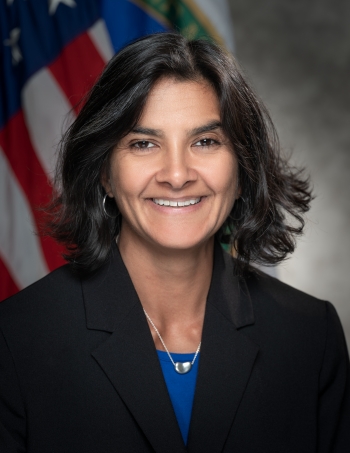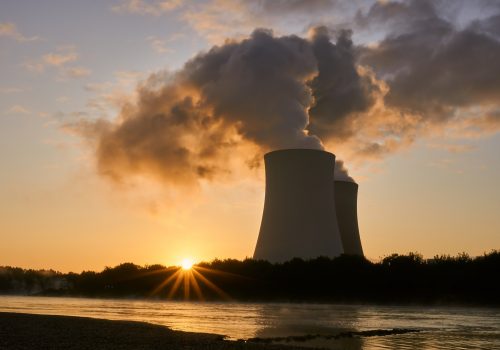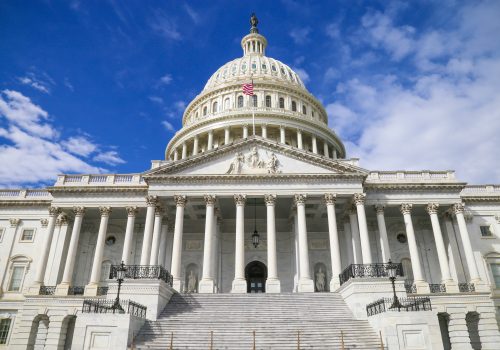As the global community continues to grapple with the coronavirus (COVID-19), the Atlantic Council is open for business. Our business, meetings, and events, however, are occurring virtually. For more information, please read an update from our President and CEO.
On April 23, the US Department of Energy released a report titled, “Restoring America’s Competitive Nuclear Energy Advantage: A strategy to assure US National Security.” The report—an outcome of the Nuclear Fuel Working Group—offers a series of recommendations to revitalize the front end of the nuclear fuel cycle, establish US leadership in advanced nuclear technology, and boost US export competitiveness. In this moderated discussion, Dr. Rita Baranwal provides an inside look at the deliberations among working group members, implications of the recommendations, and further opportunities to boost US competitiveness at home and abroad.
Event recap
On Wednesday, May 6, Dr. Rita Baranwal, assistant secretary for the US Department of Energy’s (DOE) Office of Nuclear Energy (ONE), joined Atlantic Council Global Energy Center managing editor and senior fellow Dr. Jennifer Gordon to discuss the recently released Nuclear Fuel Working Group (NFWG) report, “Restoring America’s Competitive Nuclear Energy Advantage,” and US government strategy to advance national leadership in the nuclear fuel cycle, reactor design, and exports.
The discussion started with Dr. Baranwal providing an overview of the NFWG report. This report addresses the United States’ declining global competitiveness in the nuclear industry and recommends establishing a uranium reserve, supporting public-private partnerships through the National Reactor Innovation Center (NRIC) and the Versatile Test Reactor (VTR), and continuing funding for advanced reactor concepts.
She noted that the Trump Administration and the ONE had already acted upon some of these recommendations. For example, President Donald Trump’s Fiscal Year 21 (FY21) budget requested $150 million for the creation of a uranium reserve that would involve the purchase of uranium from US mines and use of US uranium conversion services. In addition, the president officially created the NRIC in 2018 upon signing the Nuclear Energy Innovation Capabilities Act (NEIA) into law. The NRIC is led by the Idaho National Laboratory (INL) and accelerates the demonstration and eventual deployment of advanced nuclear technology through private sector partnerships.
Baranwal highlighted the importance of the VTR and Advanced Reactor Demonstration Program in particular, explaining that once the VTR is completed in 2026, it will play a critical role in facilitating the testing and development of new nuclear fuels, materials, and systems. Likewise, DOE’s ONE completed a request for information (RFI) in February 2020 for the Advanced Reactor Demonstration Program and hopes to move forward with awards by the end of the year. Addressing the uncertainty that many foreign countries and companies face when seeking to collaborate with the United States on nuclear matters, she announced that ONE was working to create a “one-stop shop” for guidance on how to navigate the inter-agency process within the US government.
Pivoting to nuclear export potential, Baranwal noted that third-party client countries purchasing US nuclear tech have not only benefited from the best nuclear technology in the world, but also the lasting relationship and trustworthiness inherent to US business engagement. Despite these benefits, the United States still faces significant competition from Russia and China, whose streamlined state-owned models and attractive financing packages have appealed to many countries seeking to develop their civilian nuclear capabilities. To level the playing field, ONE is working with the US Export-Import (EXIM) Bank, the International Framework for Nuclear Energy Cooperation (IFNEC), the Organization for Economic Cooperation and Development’s (OECD) Nuclear Energy Agency (NEA), and the World Bank to develop more amenable financing strategies for nuclear projects. It is also working on a plan to help the United States compete with countries that offer fuel buy-backs—a benefit that United States is currently unable to provide—and significant nuclear infrastructure development.
In response to Dr. Gordon’s question about the relationship between a strong domestic fleet and export potential, Baranwal affirmed that the “current operating fleet is absolutely vital for our industry.” Not only do premature reactor shutdowns stifle the United States’s ability to maintain current levels of clean electricity generation, they weaken associated US-based supply chains, fuel cycle infrastructure, and national security capabilities. ONE-led projects to develop alternative applications of nuclear energy at the state level—such as the $9.2 million award for a pilot program led by the Davis-Besse, Prairie Island, and Palo Verde power plants to evaluate their hydrogen generation capabilities for manufacturing and transportation purposes—are particularly important in maintaining the viability and relevance of the existing US nuclear fleet.
Barnwal concluded with brief remarks, emphasizing the NFWG report’s priority recommendation for a US uranium mining reserve, and additional DOE efforts to address challenges related to the back end of the fuel cycle—namely recycling, reprocessing, and storage. With regard to the former, she emphasized that fierce competition from foreign entities operating in very different economic and regulatory environments has significantly driven down domestic uranium production since the 1980s. Last year, the United States produced approximately 174,000 pounds of uranium, the lowest output level witnessed in over seventy years. The creation of a domestic uranium mining reserve, she asserted, was critical to de-risking fuel supply, creating jobs, and strengthening domestic uranium mining and conversion services. Regarding the back end of the fuel cycle, she noted that President Trump’s FY21 budget request included a proposal for interim waste storage, and that DOE is looking into the possibility of government or privately-owned interim storage at a consolidated location as part of an “integrated waste management system.” However, she reminded the audience that some changes were beyond the department’s control and would likely require modification to existing law or congressional appropriation.
A conversation with
Dr. Rita Baranwal
Assistant Secretary, Office of Nuclear Energy
US Department of Energy
Moderated by
Dr. Jennifer Gordon
Managing Editor and Senior Fellow, Global Energy Center
Atlantic Council
Featuring
Dr. Rita Baranwal, Assistant Secretary, Office of Nuclear Energy, US Department of Energy

Dr. Rita Baranwal serves as the assistant secretary for the Office of Nuclear Energy in the US Department of Energy (DOE); she was nominated by President Trump and confirmed by the US Senate to perform in this role. Dr. Baranwal leads the office’s efforts to promote research and development (R&D) on existing and advanced nuclear technologies that sustain the existing US fleet of nuclear reactors, enable the deployment of advanced nuclear energy systems, and enhance US global commercial nuclear energy competitiveness.
Prior to her current role, Dr. Baranwal directed the Gateway for Accelerated Innovation in Nuclear (GAIN) initiative at Idaho National Laboratory. She was responsible for providing the nuclear industry and other stakeholders access to DOE’s state-of-the-art R&D expertise, capabilities, and infrastructure to achieve faster and cost-effective development, demonstration, and ultimate deployment of innovative nuclear energy technologies. Under her leadership, GAIN positively impacted over 120 companies.
Before joining the US Department of Energy, Dr. Baranwal served as director of technology development & application at Westinghouse. There, she led the creation and development of game-changing technologies and managed characterization and hot cell laboratories. Her previous positions at Westinghouse included director of core engineering and manager of materials and fuel rod design. Prior to joining Westinghouse, she was a manager in materials technology at Bechtel Bettis, Inc. where she led and conducted R&D in advanced nuclear fuel materials for US naval reactors.
Related expert
Related content
Learn more about the Global Energy Center

The Global Energy Center develops and promotes pragmatic and nonpartisan policy solutions designed to advance global energy security, enhance economic opportunity, and accelerate pathways to net-zero emissions.



